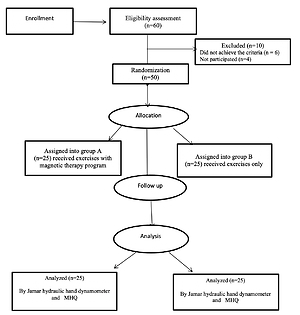Current issue
Archive
Manuscripts accepted
About the Journal
Editorial office
Editorial board
Section Editors
Abstracting and indexing
Subscription
Contact
Ethical standards and procedures
Most read articles
Instructions for authors
Article Processing Charge (APC)
Regulations of paying article processing charge (APC)
ORTHOPEDICS AND TRAUMATOLOGY / SYSTEMATIC REVIEW/META-ANALYSIS
Influence of pulsed magnetic field therapy on hand function post flexor tendon repair: a randomized controlled trial
1
Basic Science Department, Faculty of Physical Therapy, Cairo University, Cairo, Egypt
2
Biomechanics Department, Faculty of Physical Therapy, Cairo University, Cairo, Egypt
3
Department for Surgery, Faculty of Physical Therapy, Cairo University, Cairo, Egypt
4
Faculty of Medical Rehabilitation Sciences, Taibah University, KSA, Saudi Arabia
5
Basic Science Department, Faculty of Physical Therapy, Benha University, Benha, Egypt
Submission date: 2021-09-15
Final revision date: 2021-12-19
Acceptance date: 2021-12-19
Online publication date: 2021-12-27
Corresponding author
Hamada Ahmed Hamada
Assistant Professor of Biomechanics and Ergonomics, Biomechanics Department, Faculty of Physical Therapy, Cairo University, Egypt., 7 Ahmed Elziat Street, Bean Elsariate,, 12612, El Dokki, Giza, Egypt
Assistant Professor of Biomechanics and Ergonomics, Biomechanics Department, Faculty of Physical Therapy, Cairo University, Egypt., 7 Ahmed Elziat Street, Bean Elsariate,, 12612, El Dokki, Giza, Egypt
KEYWORDS
TOPICS
ABSTRACT
Introduction:
The study was conducted to investigate the influence of pulsed magnetic field therapy on hand function, grip and pinch grip strength in post flexor tendon repair patients.
Material and methods:
Fifty male patients with flexor tendon repair took part in this research, with ages ranging from 25 to 50 years. They were assigned randomly into two groups: Group A (experimental) received pulsed magnetic therapy together with exercise, whereas Group B (control) received only exercise. Evaluation of hand grip strength with Jamar hydraulic hand dynamometer, pinch strength with baseline pinch gauge and hand function with Michigan Hand Outcomes Questionnaire, all measurements were made before and after the treatment. They received 16 sessions in 8 weeks (2 sessions/week).
Results:
2 × 2 mixed design MANOVA revealed no significant difference between both groups pre- and post-treatment in MHOQ total, function, aesthetic (p > 0.05) and in hand grip strength while there was a significant difference across groups after treatment in the strength of pinch grip, MHOQ ADL, pain and satisfaction (p < 0.05); there was also a significant difference between pre- and post-treatment within groups in all outcome measures (p < 0.05).
Conclusions:
PMF increases the efficiency of physical therapy treatment, and it also increases the strength of both hand grip and pinches grip in patients after flexor tendon repair in zone II.
The study was conducted to investigate the influence of pulsed magnetic field therapy on hand function, grip and pinch grip strength in post flexor tendon repair patients.
Material and methods:
Fifty male patients with flexor tendon repair took part in this research, with ages ranging from 25 to 50 years. They were assigned randomly into two groups: Group A (experimental) received pulsed magnetic therapy together with exercise, whereas Group B (control) received only exercise. Evaluation of hand grip strength with Jamar hydraulic hand dynamometer, pinch strength with baseline pinch gauge and hand function with Michigan Hand Outcomes Questionnaire, all measurements were made before and after the treatment. They received 16 sessions in 8 weeks (2 sessions/week).
Results:
2 × 2 mixed design MANOVA revealed no significant difference between both groups pre- and post-treatment in MHOQ total, function, aesthetic (p > 0.05) and in hand grip strength while there was a significant difference across groups after treatment in the strength of pinch grip, MHOQ ADL, pain and satisfaction (p < 0.05); there was also a significant difference between pre- and post-treatment within groups in all outcome measures (p < 0.05).
Conclusions:
PMF increases the efficiency of physical therapy treatment, and it also increases the strength of both hand grip and pinches grip in patients after flexor tendon repair in zone II.
We process personal data collected when visiting the website. The function of obtaining information about users and their behavior is carried out by voluntarily entered information in forms and saving cookies in end devices. Data, including cookies, are used to provide services, improve the user experience and to analyze the traffic in accordance with the Privacy policy. Data are also collected and processed by Google Analytics tool (more).
You can change cookies settings in your browser. Restricted use of cookies in the browser configuration may affect some functionalities of the website.
You can change cookies settings in your browser. Restricted use of cookies in the browser configuration may affect some functionalities of the website.



